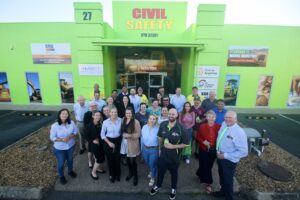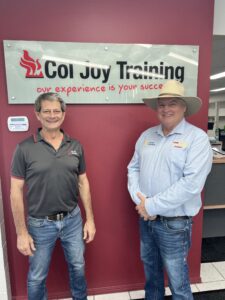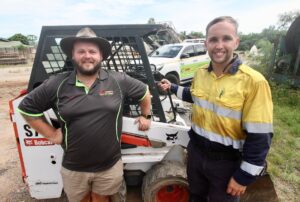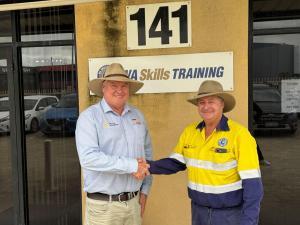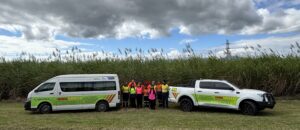Civil Safety Mackay has moved to a bigger training centre!...
Read MoreWhat Lies Beneath: What It’s Like Working Underground

The mining industry is an essential part of the Australian economy. It’s one of the largest and most important sectors in the country, with significant contributions to employment, infrastructure, exports, tax royalities, and economic growth. While images of red earth, coal, iron ore or open-cut mines might immediately come to mind, you might be surprised to learn that a lot of Australia’s mining operations actually happen underground.
However, working in an underground mine is not for the faint-hearted. It’s a challenging and demanding job that requires physical stamina, mental focus, and a keen sense of safety awareness. Yet, for those who embrace the challenge, it offers a unique and rewarding career path.
What is Underground Mining?
Underground mining is an essential component of Australia’s resource industry and refers to the extraction of minerals and resources from beneath the Earth’s surface. This intricate process involves drilling, blasting, and removing rock and ore from underground tunnels and shafts, which can be hundreds of metres below the surface. It demands specialised skills and knowledge that enables the retrieval of valuable deposits that are typically inaccessible through surface mining methods.

Benefits of Working Underground
Despite the challenges, many people are drawn to underground mining for the unique opportunities it offers. For some, it’s the chance to work with cutting-edge technology and machinery – pushing the boundaries of what’s possible in mining exploration and extraction. For others, it’s the camaraderie and teamwork fostered underground, the exciting opportunities for career advancement, and the attractive compensation packages and benefits.

A Day in the Life of an Underground Miner
A typical day for an underground miner kicks off in the early morning hours. After a hearty breakfast, they suit up in their protective gear, which usually includes a hard hat, safety glasses, steel-cap gumboots, a mine belt, cap lamp and battery, Self Contained Self Rescuer (SCSR), and high-vis clothing. Once fully suited up, miners gather with their crew for a safety briefing where they review the day’s tasks, identify any potential hazards, and ensure everyone is equipped with the necessary safety gear and tools. With safety top of mind, workers head into the underground mine, typically navigating through a network of tunnels and shafts to begin their shift.

Underground Safety
While working in an underground mine may seem daunting at first, advancements in technology have significantly improved safety standards and working conditions in modern underground mines. Safety is the top priority in any mining operation, with strict protocols and regulations in place to protect workers. Cutting-edge equipment, like gas detectors and ventilation systems continuously monitor air quality and potential hazards, ensuring a safe working environment.
Comfort is also a priority in modern underground mines. Gone are the days of dimly lit tunnels and carrying in canaries to see if they pass out. Advances in lighting technology have made it possible to illuminate mines, creating well-lit working environments where miners can see and work more effectively. Ventilation systems play a crucial role in maintaining a comfortable temperature and air quality within the mine. These systems circulate fresh air throughout the tunnels, removing any potentially harmful gases or dust particles, and enhancing the overall working conditions underground.

Underground Mining Methods
There are two main types of underground mining methods used in Queensland coal mines, each suited to different geological conditions, resource types, and mining objectives.
Board and pillar mining: This method involves creating a series of tunnels underground, leaving pillars of untouched material to provide support to the mine structure.
Longwall mining: In this method, a long wall of coal, ore, or mineral deposit is mined in a single slice. The section of rock that is being mined, known as the longwall panel, is typically 3–4 km, but can be longer.
Top Coal caving: Additional to the longwall method is top coal caving, by which a pan and chain is located behind the roof supports to remove any coal left behind by the longwall cutting process. It is a more efficient way to ensure that the coal is not left behind in the GOAF (the part of the mine from which the coal has been worked away).
Ready to pursue an exciting underground mining career?
Civil Safety offers a variety of nationally accredited courses to help you pursue your career or upskill in the Queensland mining industry. If you’re considering a career in a QLD underground mine, the first two compulsory courses you’ll need to complete are:
If you’re already working in mining and looking to develop new skills or take a step up, take some time to view our mining courses.
About Civil Safety
Civil Safety is a leading Registered Training Organisation (RTO 32381) for the mining, civil and construction industries, with operations across Queensland and Western Australia.
We provide safety and operational training to thousands of people every year from a diverse range of backgrounds. Our highly experienced trainers bring real-world experience to the classroom – ensuring our students graduate ready for work with the skills, confidence and qualifications required for safe and compliant operation in dangerous environments.
With a vast range of courses, plus a variety of learning methods including face-to-face, blended and online – we can help you gain the skills you need to enter a new industry or upskill in your current career.
Find out more information on the range of mining courses we offer, or give us a call on 1300 CIVIL S.
Civil Safety Student Brett Snodgrass Wins Vocational Student of the Year
Celebrate Brett Snodgrass, our Civil Safety student who won Vocational...
Read MoreContinuing a Legacy in Mackay – Civil Safety Acquires Col Joy Training
Discover how Civil Safety's acquisition of Col Joy Training enhances...
Read MoreShaping Futures: Civil Safety Students Shine as Finalists in 2025 Queensland Training Awards
Meet our exceptional Civil Safety students, finalists in the 2025...
Read MoreCivil Safety Continues Western Australian Expansion with Acquisition of WA Skills Training
Civil Safety Continues Western Australian Expansion with Acquisition of WA...
Read MoreMental Health Matters: Supporting Wellbeing in High-Risk Industries
Mental Health Matters: Supporting Wellbeing in High-Risk Industries In the...
Read MoreTrinity Bay SHS Students Visit Local Cane Farms as Part of Rural Ops Training
Trinity Bay SHS Students Visit Local Cane Farms as Part...
Read MoreCivil Safety Backs Rockhampton Boxing and Sport Promotions Club in 5-Year Sponsorship to Empower Local Youth
Civil Safety Backs Rockhampton Boxing and Sport Promotions Club in...
Read More
